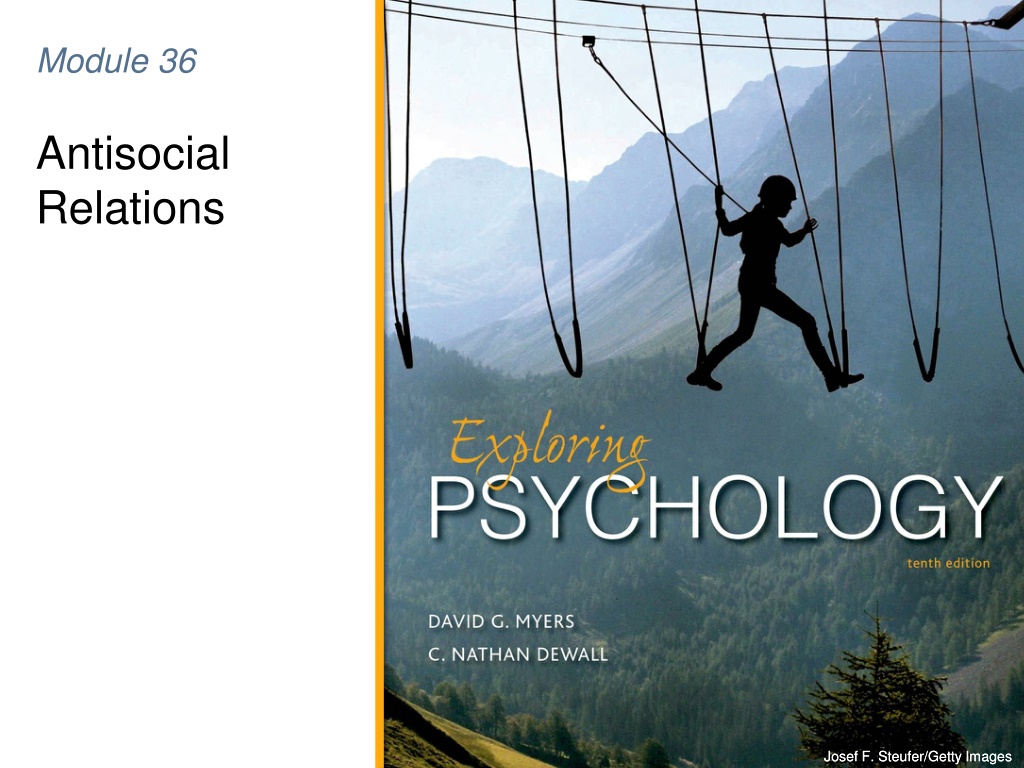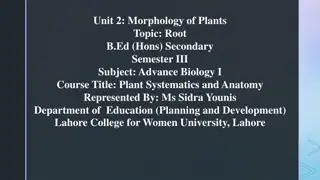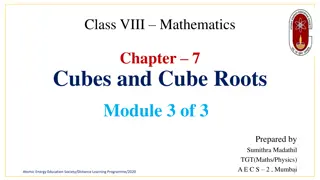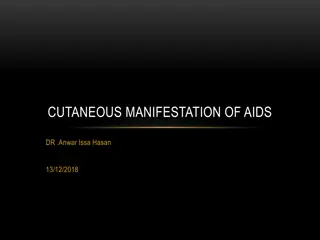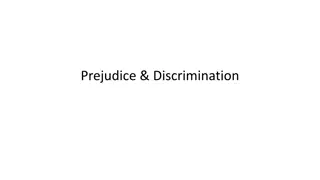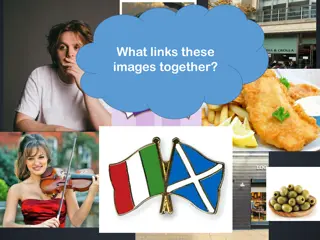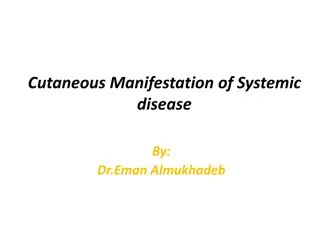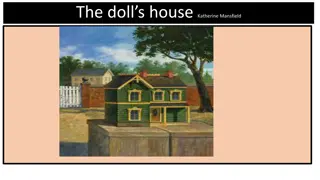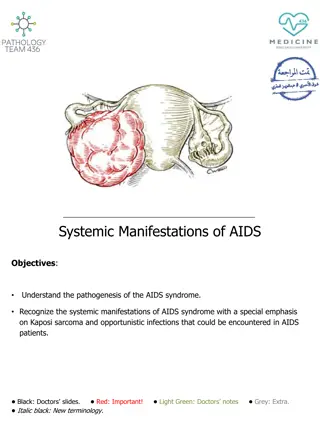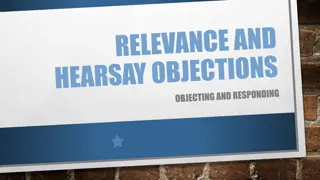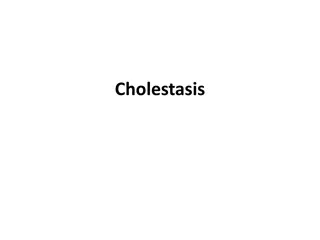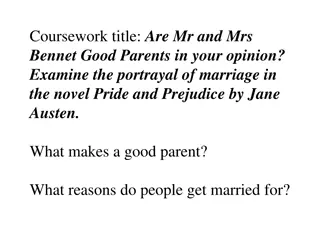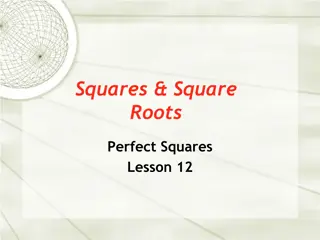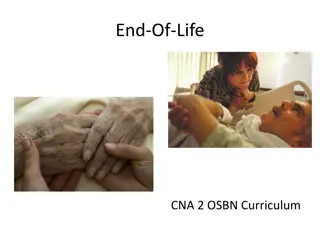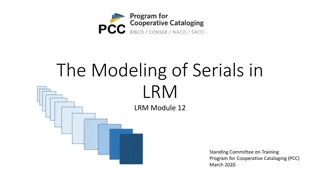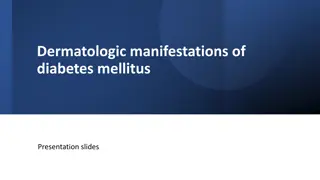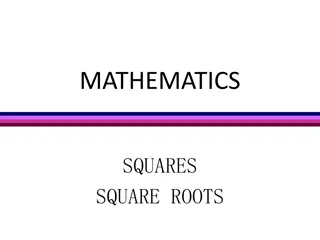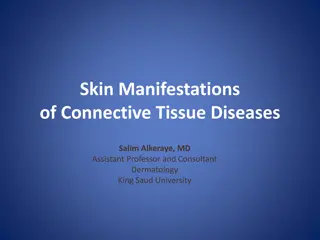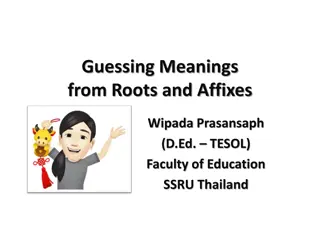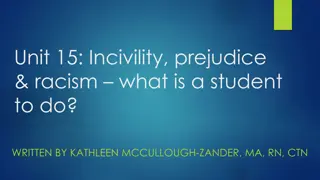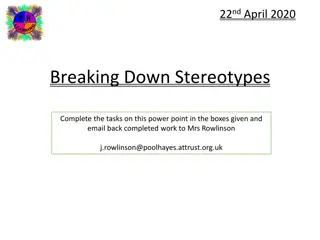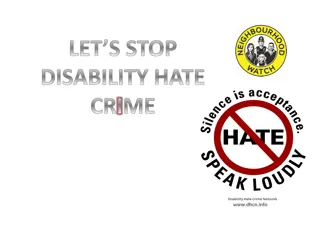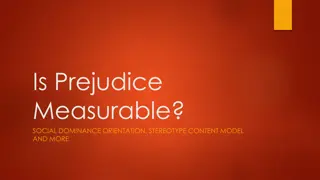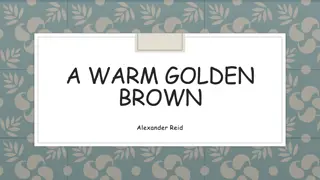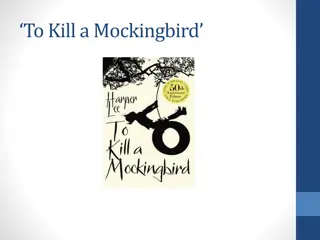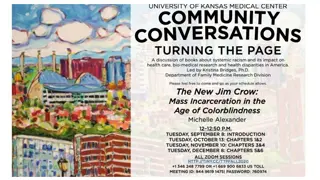Understanding Prejudice: Roots, Manifestations, and Impact on Society
Prejudice is an unjustified negative attitude towards a group, stemming from beliefs, emotions, and predispositions to discriminate. This negative behavior can lead to discrimination, affecting various aspects of society such as job opportunities and relationships. Despite a decline in overt prejudices, implicit biases still exist and can influence actions even without conscious discriminatory intent. Monitoring feelings and actions can help combat these biases effectively.
Uploaded on Sep 26, 2024 | 0 Views
Download Presentation

Please find below an Image/Link to download the presentation.
The content on the website is provided AS IS for your information and personal use only. It may not be sold, licensed, or shared on other websites without obtaining consent from the author. Download presentation by click this link. If you encounter any issues during the download, it is possible that the publisher has removed the file from their server.
E N D
Presentation Transcript
Module 36 Antisocial Relations Josef F. Steufer/Getty Images Josef F. Steufer/Getty Images
Antisocial Relations Prejudice 36-1: WHAT IS PREJUDICE? WHAT ARE ITS SOCIAL AND EMOTIONAL ROOTS? Prejudice Means prejudgment Is an unjustified negative attitude toward a group and its members Often targets a different cultural, ethnic, or gender group Components Beliefs (stereotypes) Emotions (for example, hostility or fear) Predispositions to action (to discriminate)
Antisocial Relations Prejudice Prejudice is a negative attitude. To believe that obese people are gluttonous, and to feel dislike for an obese person, is to be prejudiced; prejudice is a negative attitude. To pass over all the obese people on a dating site, or to reject an obese person as a potential job candidate, is to discriminate; discrimination is a negative behavior. Discrimination is a negative behavior.
Antisocial Relations Prejudice How Prejudiced Are People? Prejudice comes as both explicit (overt) and implicit (automatic) attitudes toward people of a particular ethnic group, gender, sexual orientation, or viewpoint. Explicit Ethnic Prejudice Explicit ethnic prejudice in North America has decreased over time. Expressed support today for all forms of racial contact, including the once unpopular idea of interracial dating. Overt prejudice has waned; subtle prejudice lingers. Prejudice can be automatic and unconscious.
Antisocial Relations Prejudice How Prejudiced Are People? Implicit Ethnic Prejudice Implicit racial associations Implicit Association Tests results: Even people who deny racial prejudice may carry negative associations Unconscious patronization Lower expectations, inflated praise and insufficient criticism for minority student achievement Race-influenced perceptions Fatigue can increase automatic reactions that amplify racial bias Unconscious prejudices can cause discrimination even without conscious discriminatory intent, but monitoring feelings and actions can help significantly diminish both
Antisocial Relations Prejudice How Prejudiced Are People? Gender Prejudice Overt gender prejudice has also declined sharply, but gender prejudice and discrimination persist For example, people tend to perceive their fathers as more intelligent than their mothers, despite equality between the sexes in intelligence test scores. Gender inequality in wages For example, we pay more to those (usually men) who care for our streets than to those (usually women) who care for our children. Worldwide, more women than men live in poverty, there are more illiterate women than men, 30 percent of women have experienced intimate partner violence, and sons are often valued more than daughters.
Antisocial Relations Prejudice How Prejudiced Are People? Sexual Orientation Prejudice Dozens of countries have laws criminalizing same-sex relationships Anti-gay prejudice, though rapidly subsiding in Western countries, still persists. In national surveys, 39 percent of LGBT Americans reported having been rejected by a friend or family member because of their sexual orientation or gender identity. And 58 percent reported being subject to slurs or jokes (Pew, 2013). LGBT experience: Higher rates of depressive, anxiety, and alcohol use disorders Higher rates of cardiovascular deaths
Antisocial Relations Prejudice Social Roots of Prejudice Why does prejudice arise? Social inequalities and divisions are partly responsible. Social Inequalities Social inequalities: The privileged often developed attitudes that justify the status quo. Just-world phenomenon: Good is rewarded and evil is punished. Stereotypes rationalize inequalities. Victims of discrimination may react in ways that feed prejudice, in a classic blame-the-victim dynamic: Circumstances of poverty breed a higher crime rate, for example, which then can be used as a justification for discrimination.
Antisocial Relations Prejudice Social Roots of Prejudice Us and Them: Ingroup and Outgroup Through social identities people associate themselves with certain groups and contrast ourselves with others. Evolution prepares people to identify with a group: Ingroup: us people with whom we share a common identity Social definition of who we are includes who we are not Outgroup: them those perceived as different or apart from our group Ingroup bias: Favoring of our own group
Antisocial Relations Prejudice Emotional Roots of Prejudice Scapegoat theory proposes that when things go wrong, finding someone to blame can provide an outlet for anger Philip Zimbardo (2001) on terrorism: Fear and anger create aggression, and aggression against citizens of different ethnicity or race creates racism and, in turn, new forms of terrorism. Prejudice levels tend to be high among economically frustrated people In experiments, a temporary frustration increases prejudice Negative emotions feed prejudice
Antisocial Relations Prejudice Cognitive Roots of Prejudice 36-2: WHAT ARE THE COGNITIVE ROOTS OF PREJUDICE? Stereotyped beliefs are a by-product of how we cognitively simplify the world. Forming Categories Humans categorize people by race: mixed-race people often identified by minority identity. Similarities of others overestimated during categorization, creating We and They. Other-race effect (also called the cross-race effect and the own-race bias): The tendency to recall faces of one s own race more accurately than faces of other races.
CATEGORIZING MIXED-RACE PEOPLE When New Zealanders quickly classified 104 photos by race, those of European descent more often than those of Chinese descent classified the ambiguous middle two as Chinese (Halberstadt et al., 2011).
Antisocial Relations Prejudice Cognitive Roots of Prejudice Vivid Cases Feed Stereotypes
Antisocial Relations Aggression 36-3: HOW DOES PSYCHOLOGY S DEFINITION OF AGGRESSION DIFFER FROM EVERYDAY USAGE? WHAT BIOLOGICAL FACTORS MAKE US MORE PRONE TO HURT ONE ANOTHER? Aggression: Any physical or verbal behavior intended to harm someone physically or emotionally Examples of aggressive behavior: passing along vicious rumors, bullying in person or online, physical attack Aggressive behavior results from interaction of biology and experience
Antisocial Relations: Aggression The Biology of Aggression Biology influences aggression at three levels. Genetic Influences Evidence from animal studies and twin studies; the male Y chromosome is a genetic marker, as is the MAOA gene People who have low MAOA gene expression tend to behave aggressively when provoked Neural Influences Neural systems facilitate or inhibit aggression when provoked Aggression more likely to occur with frontal lobe damage Biochemical Influences Testosterone influences the neural systems that control aggression Alcohol effect unleashes aggressive responses (even just thinking you ve consumed it has an effect)
Antisocial Relations: Aggression Psychological and Social-Cultural Factors in Aggression 36-4: WHAT PSYCHOLOGICAL AND SOCIAL-CULTURAL FACTORS MAY TRIGGER AGGRESSIVE BEHAVIOR? Aversive Events Frustration-aggression principle: Frustration creates anger, which can spark aggression Reinforcement, Modeling, and Self-Control Previous reinforcement for aggressive behavior, observing an aggressive role model, and poor self- control may all trigger aggression Hot temperatures, physical pain, personal insults, foul odors, cigarette smoke, crowding, and a host of other aversive stimuli may also evoke hostility Manly honor and culture-of-honor traditions may encourage aggressive behavior
Antisocial Relations: Aggression Psychological and Social-Cultural Factors in Aggression Media Models for Violence Media portrayals of violence provide social scripts that children learn to follow. Viewing sexual violence contributes to greater aggression toward women. Playing violent video games increases aggressive thoughts, emotions, and behaviors.
Antisocial Relations: Aggression Psychological and Social-Cultural Factors in Aggression Men Who Sexually Coerce Women
Antisocial Relations: Aggression Psychological and Social-Cultural Factors in Aggression Do Violent Video Games Teach Social Scripts for Violence? Nearly 400 studies of 130,000 people suggest video games can prime aggressive thoughts, decrease empathy, and increase aggression. Some researchers dispute this finding and note other factors they say may be more important : Depression, family violence, and peer influence. COINCIDENCE OR CAUSE? In 2011, Norwegian Anders Behring Breivik bombed government buildings in Oslo, and then went to a youth camp where he shot and killed 69 people, mostly teens. How is this related to effects of media violence?
Antisocial Relations: Aggression Psychological and Social-Cultural Factors in Aggression
